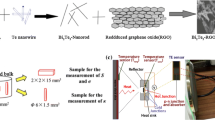Abstract
Recently, it was found that element semiconductor tellurium (Te) has a high thermoelectric performance. However, it needs to be doped with high-toxic arsenic (As) to tune the carrier concentration of Te. In this paper, low-toxic bismuth (Bi) was employed as dopant to optimize the thermoelectric performance of Te combining with a high-pressure synthesis method. The effect of substituting Bi on the electrical transport and thermal transport properties of Te has been investigated. The results show that the solubility limit of Bi in Te is about 0.1 mol%. However, the trace amounts of Bi doping can tune the carrier concentration of Te effectively and thereby optimize its power factor. The thermal conductivity of non-doped Te prepared by high pressure is much lower than that of the sample prepared at ambient pressure. And Bi doping can further decrease the value due to the phonons scattered by the heavy impurity atom. An enhanced figure of merit ZT ~ 0.72 was obtained at 517 K, which is about four times that of non-doped Te and is comparable to the state-of-the-art thermoelectric alloys with more complex composition such as Bi2Te3 and PbTe.







Similar content being viewed by others
References
Ning H, Reece MJ, Smeacetto F et al (2016) Oxidation protective glass–ceramic coating for higher manganese silicide thermoelectrics. J Mater Sci 51:9484–9489. doi:10.1007/s10853-016-0192-1
Femi OE, Ravishankar N, Chattopadhyay K (2016) Microstructure evolution and thermoelectric properties of Te-poor and Te-rich (Bi, Sb)2Te3 prepared via solidification. J Mater Sci 51:7254–7265. doi:10.1007/s10853-016-0008-3
Schmitz A, Boor J, Mull K et al (2016) Tailoring the mechanical properties of thermoelectric lead telluride by alloying with non-doping calcium. J Mater Sci 51:6933–6943. doi:10.1007/s10853-016-9980-x
Lin S, Li W, Chen Z et al (2016) Tellurium as a high-performance elemental thermoelectric. Nat Commun 7:10287
Yang M, Zhu H, Li H et al (2017) Electrical transport and thermoelectric properties of PbTe1−xIx synthesized by high pressure and high temperature. J Alloy Compd 696:161–165
Su T, Zhu P, Ma H et al (2006) Electrical transport and thermoelectric properties of PbTe doped with Sb2Te3 prepared by high-pressure and high-temperature. J Alloy Compd 422:328–331
Su T, Zhu P, Ma H et al (2006) Electrical transport and high thermoelectric properties of PbTe doped with Bi2Te3 prepared by HPHT. Solid State Commun 138:580–584
Mizuguchi Y, Miura O (2016) High-Pressure Synthesis and Superconductivity of Ag-doped Topological Crystalline Insulator SnTe (Sn1−x Ag x Te with x = 0−0.5). J Phys Soc Jpn 85(5):053702
Thonhauser T, Jeon GS, Mahan GD, Sofo JO (2003) Stress-induced defects in Sb2Te3. Phys Rev B 68:205207
Parthasarathy G, Holzapfel WB (1988) High-pressure structural phase transitions in tellurium. Phys Rev B 37:8499
Bridgman PW (1952) The resistance of 72 elements, alloys and compounds to 100,000 Kg/Cm2. Proc Am Acad Arts Sci 81(4):165
Zhou X, He D, Wang S, Wang H, Zhang J, Zhao Y (2013) New exploration on phase transition and structure of PbS under high pressure and temperature. J Appl Phys 113:043509
Fukuroi T, Tanuma S, Tobisawa S (1952) Electrical properties of antimony-doped tellurium crystals. Sci Rep Res Inst Ser A 4:283–297
Anzin VB, Eremets MI, Kosichkin YV et al (1977) Measurement of the energy gap in tellurium under pressure. Phys Status Solidi A 42:385–389
Goldsmid HJ, Sharp JW (1999) Estimation of the thermal band gap of a Semiconductor from seebeck measurements. J Electron Mater 28:869–872
Zhou B, Liu B, Jiang LP et al (2007) Ultrasonic-assisted size-controllable synthesis of Bi2Te3 nanoflakes with electrogenerated chemiluminescence. Ultrason Sonochem 14:229
Ricco AJ, White HS, Wrighton MS (1984) X-ray photoelectron and Auger electron spectroscopic study of the CdTe surface resulting from various surface pretreatments: correlation of photoelectrochemical and capacitance-potential behavior with surface chemical composition. J Vac Sci Technol A 2:910
Rowe DM (1995) CRC Handbook of Thermoelectrics. CRC, Boca Raton
Zhu P, Imai Y, Isoda Y et al (2006) Composition-dependent thermoelectric properties of PbTe doped with Bi2Te3. J Alloy Compd 420:233–236
Kim KS, Gibbs ZM, Tang Y et al (2015) Characterization of Lorenz number with seebeck coefficient measurement. APL Mater 3:041506
Thonhauser T, Jeon GS, Mahan GD et al (2003) Stress-induced defects in Sb2Te3. Phys Rev B 68:205207
Parker D, Singh DJ (2011) Potential thermoelectric performance from optimization of Hole-Doped Bi2Se3. Phys Rev X 1:021005
Heremans JP, Jovovic V, Toberer ES et al (2008) Enhancement of thermoelectric efficiency in PbTe by distortion of the electronic density of states. Science 321:554–558
Acknowledgements
This work was supported by the Fundamental Research Funds for the Universities of Henan Province (NSFRF140202) and the Outstanding Youth Funds of Henan Polytechnic University (J2016-5). We thank Wei Zhang in Wuhan Joule Yacht Science & Technology CO., Ltd for testing the electrical resistivity and Seebeck coefficient. We also thank Haiqiang Liu, Yuewen Zhang and Ning Chen in Jilin University for measuring the microstructure and XPS.
Author information
Authors and Affiliations
Corresponding authors
Ethics declarations
Conflict of interest
The authors declare that they have no conflict of interest.
Electronic supplementary material
Below is the link to the electronic supplementary material.
Rights and permissions
About this article
Cite this article
Yang, M., Su, T., Zhou, D. et al. High-pressure synthesis and thermoelectric performance of tellurium doped with bismuth. J Mater Sci 52, 10526–10532 (2017). https://doi.org/10.1007/s10853-017-1180-9
Received:
Accepted:
Published:
Issue Date:
DOI: https://doi.org/10.1007/s10853-017-1180-9




